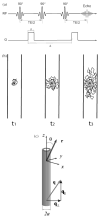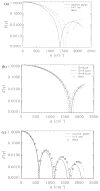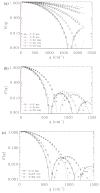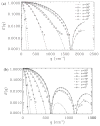Three-dimensional water diffusion in impermeable cylindrical tubes: theory versus experiments
- PMID: 18574856
- PMCID: PMC7477620
- DOI: 10.1002/nbm.1277
Three-dimensional water diffusion in impermeable cylindrical tubes: theory versus experiments
Abstract
Characterizing diffusion of gases and liquids within pores is important in understanding numerous transport processes and affects a wide range of practical applications. Previous measurements of the pulsed gradient stimulated echo (PGSTE) signal attenuation, E(q), of water within nerves and impermeable cylindrical microcapillary tubes showed it to be exquisitely sensitive to the orientation of the applied wave vector, q, with respect to the tube axis in the high-q regime. Here, we provide a simple three-dimensional model to explain this angular dependence by decomposing the average propagator, which describes the net displacement of water molecules, into components parallel and perpendicular to the tube wall, in which axial diffusion is free and radial diffusion is restricted. The model faithfully predicts the experimental data, not only the observed diffraction peaks in E(q) when the diffusion gradients are approximately normal to the tube wall, but their sudden disappearance when the gradient orientation possesses a small axial component. The model also successfully predicts the dependence of E(q) on gradient pulse duration and on gradient strength as well as tube inner diameter. To account for the deviation from the narrow pulse approximation in the PGSTE sequence, we use Callaghan's matrix operator framework, which this study validates experimentally for the first time. We also show how to combine average propagators derived for classical one-dimensional and two-dimensional models of restricted diffusion (e.g. between plates, within cylinders) to construct composite three-dimensional models of diffusion in complex media containing pores (e.g. rectangular prisms and/or capped cylinders) having a distribution of orientations, sizes, and aspect ratios. This three-dimensional modeling framework should aid in describing diffusion in numerous biological systems and in a myriad of materials sciences applications.
Copyright (c) 2008 John Wiley & Sons, Ltd.
Figures






Similar articles
-
A general framework to quantify the effect of restricted diffusion on the NMR signal with applications to double pulsed field gradient NMR experiments.J Chem Phys. 2009 Mar 14;130(10):104702. doi: 10.1063/1.3082078. J Chem Phys. 2009. PMID: 19292544 Free PMC article.
-
Microscopic anisotropy revealed by NMR double pulsed field gradient experiments with arbitrary timing parameters.J Chem Phys. 2008 Apr 21;128(15):154511. doi: 10.1063/1.2905765. J Chem Phys. 2008. PMID: 18433239 Free PMC article.
-
NMR relaxation and pulsed field gradient study of alginate bead porous media.J Magn Reson. 2004 Aug;169(2):203-14. doi: 10.1016/j.jmr.2004.04.016. J Magn Reson. 2004. PMID: 15261615
-
Measuring small compartmental dimensions with low-q angular double-PGSE NMR: The effect of experimental parameters on signal decay.J Magn Reson. 2009 May;198(1):15-23. doi: 10.1016/j.jmr.2009.01.004. Epub 2009 Jan 13. J Magn Reson. 2009. PMID: 19186086
-
Diffusion-weighted imaging in tissues: theoretical models.NMR Biomed. 1995 Nov-Dec;8(7-8):289-96. doi: 10.1002/nbm.1940080704. NMR Biomed. 1995. PMID: 8739267 Review.
Cited by
-
From single-pulsed field gradient to double-pulsed field gradient MR: gleaning new microstructural information and developing new forms of contrast in MRI.NMR Biomed. 2010 Aug;23(7):757-80. doi: 10.1002/nbm.1550. NMR Biomed. 2010. PMID: 20690130 Free PMC article. Review.
-
The sensitivity of diffusion MRI to microstructural properties and experimental factors.J Neurosci Methods. 2021 Jan 1;347:108951. doi: 10.1016/j.jneumeth.2020.108951. Epub 2020 Oct 2. J Neurosci Methods. 2021. PMID: 33017644 Free PMC article. Review.
-
A general framework to quantify the effect of restricted diffusion on the NMR signal with applications to double pulsed field gradient NMR experiments.J Chem Phys. 2009 Mar 14;130(10):104702. doi: 10.1063/1.3082078. J Chem Phys. 2009. PMID: 19292544 Free PMC article.
-
Novel pore size-controlled, susceptibility matched, 3D-printed MRI phantoms.Magn Reson Med. 2024 Jun;91(6):2431-2442. doi: 10.1002/mrm.30029. Epub 2024 Feb 18. Magn Reson Med. 2024. PMID: 38368618 Free PMC article.
-
Ensemble average propagator-based detection of microstructural alterations after stroke.Int J Comput Assist Radiol Surg. 2016 Sep;11(9):1585-97. doi: 10.1007/s11548-016-1442-z. Epub 2016 Jul 1. Int J Comput Assist Radiol Surg. 2016. PMID: 27368185
References
-
- DeGennes PG. Scaling Concepts in Polymer Physics. Cornell University Press; Ithaca, NY: 1976.
-
- Kimmich R, Bachus R. NMR field-cycling relaxation spectroscopy, transverse NMR relaxation, self-diffusion and zero-shear viscosity: defect diffusion and reptation in non-glassy amorphous polymers. Colloid Polym Sci. 1982;260(10):911–936.
-
- Davis ME. Ordered porous materials for emerging applications. Nature. 2002;417:813–821. - PubMed
-
- Hubbell JA. Biomaterials in tissue engineering. Nat Biotechnol. 1995;13:565–576. - PubMed
-
- King MD, Houseman J, Roussel SA, van Bruggen N, Williams SR, Gadian DG. q-Space imaging of the brain. Magn Reson Med. 1994;32(6):707–713. - PubMed
Publication types
MeSH terms
Substances
Grants and funding
LinkOut - more resources
Full Text Sources

